Here's a secret every Indian knows well: when you are down in the dumps or forced to stay indoors because of nasty weather, make and eat some pakoras. They are guaranteed to infuse sunshine into the darkest of days!
Making a restaurant-quality pakora at home is so easy, and this recipe can be made with nearly any quick-cooking veggie of your choice. You can serve the pakora as a snack with a cup of masala chai, or as a side with an Indian meal.
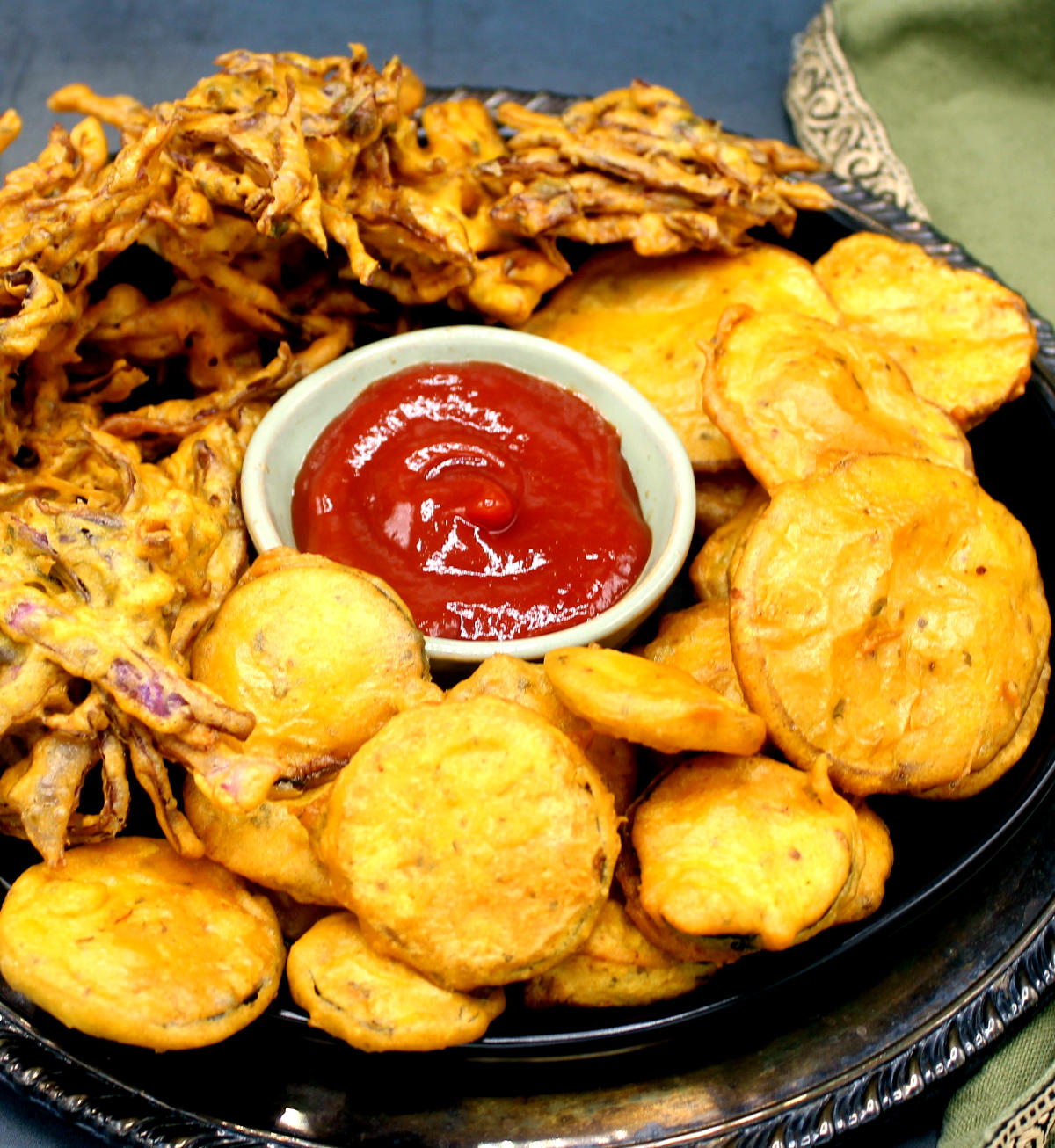
Table of Contents
What's a pakora?
Pakoras, also called pakoda, bhaji or bhajia across India, are fritters made usually by dunking chopped or sliced veggies in a simple, chickpea-flour batter. The fritters are then deep-fried until they are golden with crispy, brown edges. Vegetable pakoras are the most common, but you can frequently find pakoras made with meat and paneer, an Indian cottage cheese.
The pakoras we ate growing up were always made at home, although you can find pakoras served as a street food in India.
This vegetable pakora recipe makes a lot of pakoras so it's perfect if you are expecting a crowd. Or save leftovers (if you have any, I never do) and reheat for a much-anticipated snack for another time!
A crispy, crunchy, healthy-ish snack
- These pakoras are perfectly spiced and crispy. The veggies hiding underneath that golden coat melt in your mouth. While a deep-fried food can't exactly be called healthy, all the ingredients that go into a pakora are really good for you. Follow my tips below to ensure the pakoras absorb very little oil.
- This is a versatile recipe. Once you've mastered the batter, you can make pakoras with nearly any veggie, and even with leafies (like these Swiss chard fritters). It's a great way to get tough-to-love veggies like eggplant and okra into those little bellies. I also shared with you, years ago, a recipe for zucchini blossom pakoras, which are a rare summer treat.
- It is easy to make pakoras. Just make sure you get the batter to the right thickness and do not over-fry the pakoras (see more on this in the tips below).
- A family-friendly recipe that everyone is guaranteed to love. The veg pakoras are also nut-free, soy-free, gluten-free and vegan.
Ingredients for vegetable pakora
- Chickpea flour (besan). The flour sold here in the United States as garbanzo bean flour is more coarsely ground and is not suitable for pakoras. You need besan, which is more finely ground and forms a consistent, smooth batter. You can buy besan easily at an Indian store or online.
- Rice flour. The rice flour is optional but it adds more crunch and helps keep the pakoras crunchy long after you've cooked them. I like adding it when I make pakoras and I recommend you do too.
- Spices: turmeric (for that great, golden color), cayenne or any red chilli powder that's moderately spicy, ajwain or carom seeds, and cumin seeds.
- 1 tablespoon kasoori methi (optional). This adds nice flavor but leave it out if you don't have it, or add a teaspoon of dry mint leaves. You can also use two tablespoons of finely chopped fresh cilantro.
- 5 cups chopped vegetables. This time I used a cup of purple cabbage, 1 medium zucchini, 1 potato and 1 medium onion (cabbage makes amazing pakora). See notes below for additional veggies you can use.
- Oil for deep frying. Although I usually use avocado oil for most cooking, I use peanut oil for most of my deep frying, as most Indians would. It is also more economical. However, you can use any vegetable oil that has a high smoke point, including sunflower oil, safflower oil, canola oil, or avocado oil. Stay away from olive oil and coconut oil when making pakoras for the most authentic flavor.
Vegetable substitutions
You can use any of these instead of the veggies I used above.
- Cauliflower, cut into small florets. Broccoli would work too.
- Eggplant. Try and use slimmer eggplants, like Indian, Chinese or Japanese eggplants, and slice them thin.
- Bell peppers. Bell peppers make amazing pakoras. Use bell peppers of any color.
- Okra. Cut the okra into 1-inch pieces and keep the batter a bit thick so it clings to the okra.
- Carrots. Carrots are a great veggie to use in pakora. Cut into thin slices.
- Any leafy vegetable. Spinach is great in pakoras, as is kale or almost any leafy. Here's my methi pakora recipe, made with fenugreek leaves. If using a leafy, keep the batter a bit thicker, because you'll need to mix the veggies into the batter and then add clumps of it to the wok or fryer.
- Zucchini blossoms
- Asparagus. I've shared with you a recipe for a baked asparagus pakora before. If you decide to deep-fry, make sure you chop the asparagus into smaller pieces and, again, keep the batter thick so it doesn't just slide off the slick asparagus stems.
- Corn. I've shared with you a no-oil corn pakora recipe and you can use a similar batter to make fried pakoras.
- Tofu. Tofu makes awesome pakoras, which taste similar to paneer pakora. Cube extra firm or superfirm tofu, dip it in the batter, and fry.
How to make vegetable pakora
- Heat oil. A wok is preferable, but if you don't have it a cast iron skillet or frying pan will work just as well. Or, if you have a deep fryer, use that.
- Chop the vegetables. Slice veggies like potatoes and zucchini thinly, using a knife or a mandolin. You want them to cook quickly in the oil. Chop the onions and cabbage into long, thin strands. You can make them as long or short as you like, I like mine gracefully long because I love how they look once they are fried.
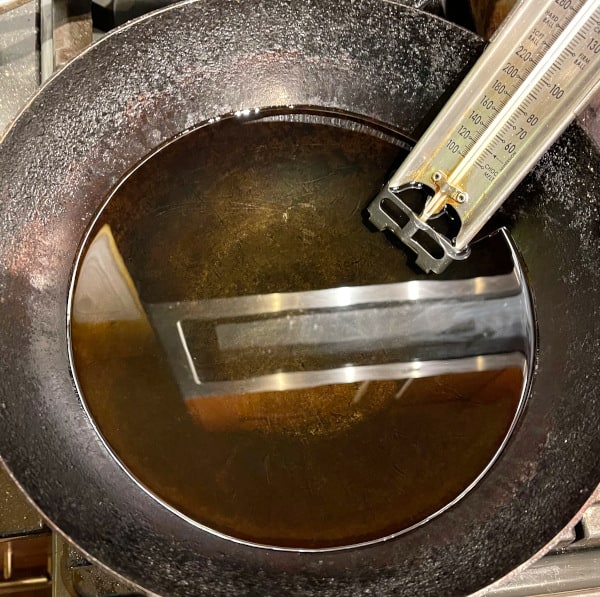
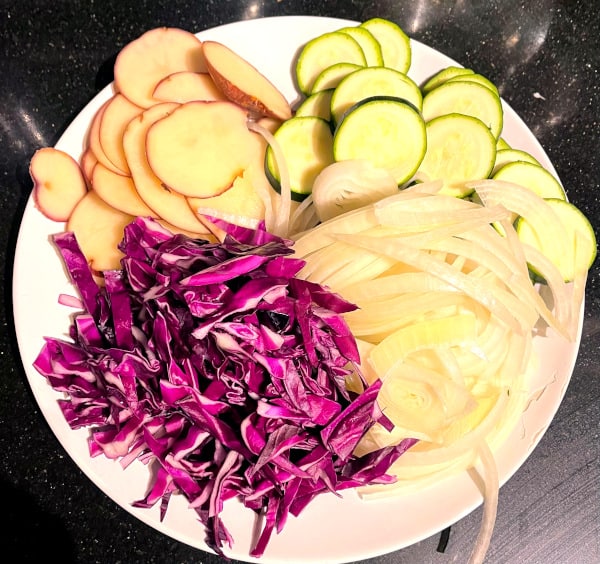
- Whisk batter ingredients together: Place all the ingredients except the vegetables in a bowl. If the chickpea flour seems lumpy, sift it into the bowl. Whisk all the ingredients to mix.
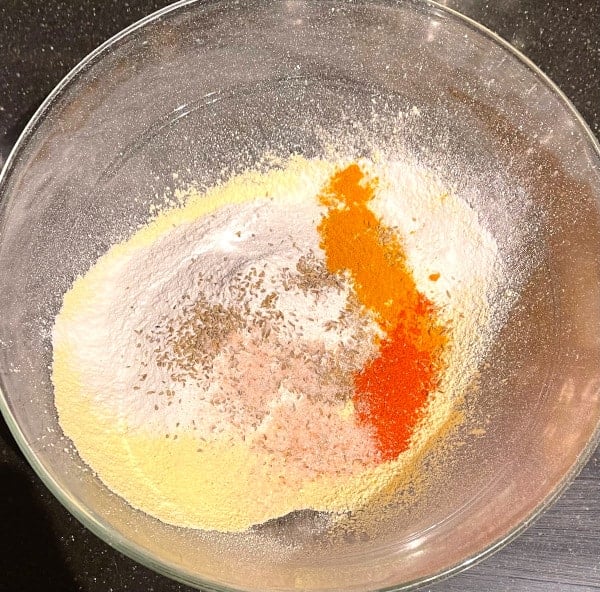
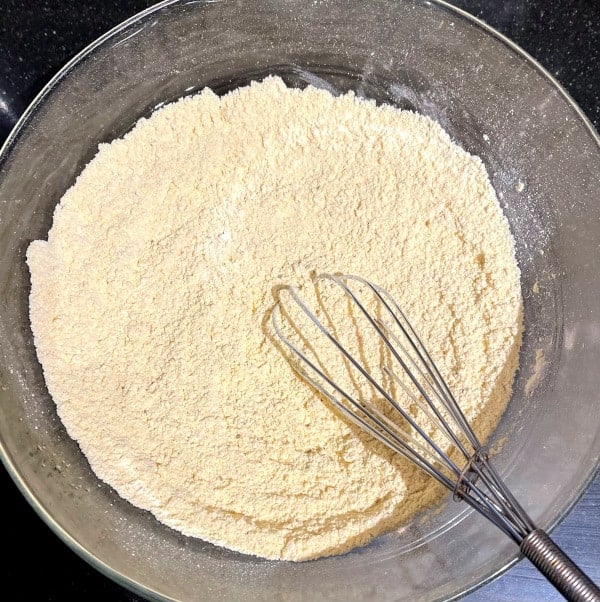
- Add the water: Slowly begin to trickle in the water, a quarter cup at a time. Whisk, and then add more. Doing this will ensure you end up with a smooth, not lumpy, batter. It's very hard to get the lumps out of the batter once you've added all the water, so doing this slowly is really important.
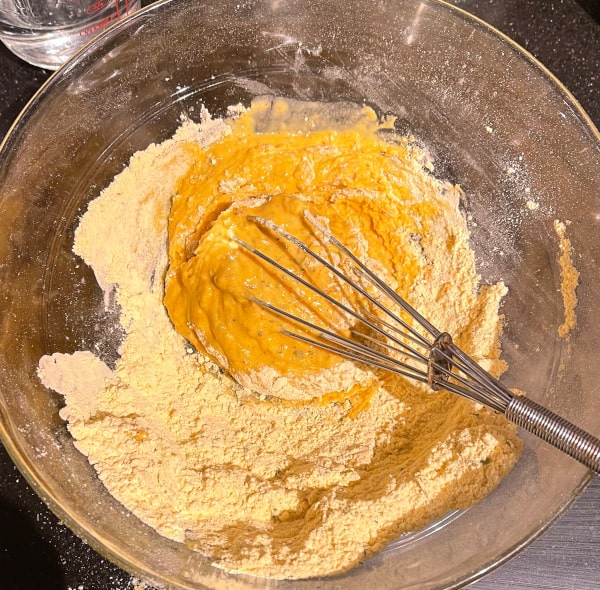
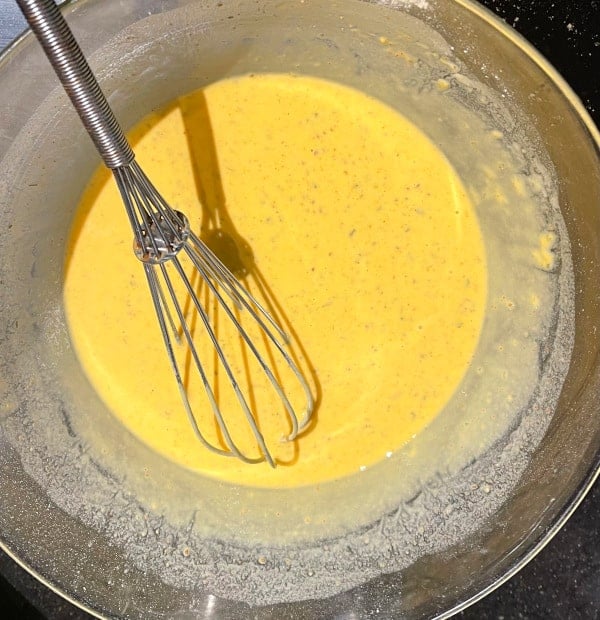
- Check the consistency of the batter. Dip a veggie in the batter--I used a potato as you can see in the picture below. The excess batter should easily drip off while leaving a nice, even coating over the potato. You don't want a very thick batter because you should be able to taste the veggie and not just the coating, but you don't want a batter so thin that it just slides off the vegetable. To make pakoras with leafy veggies, or with veggies that have a slick surface like okra and asparagus, make the batter thicker.
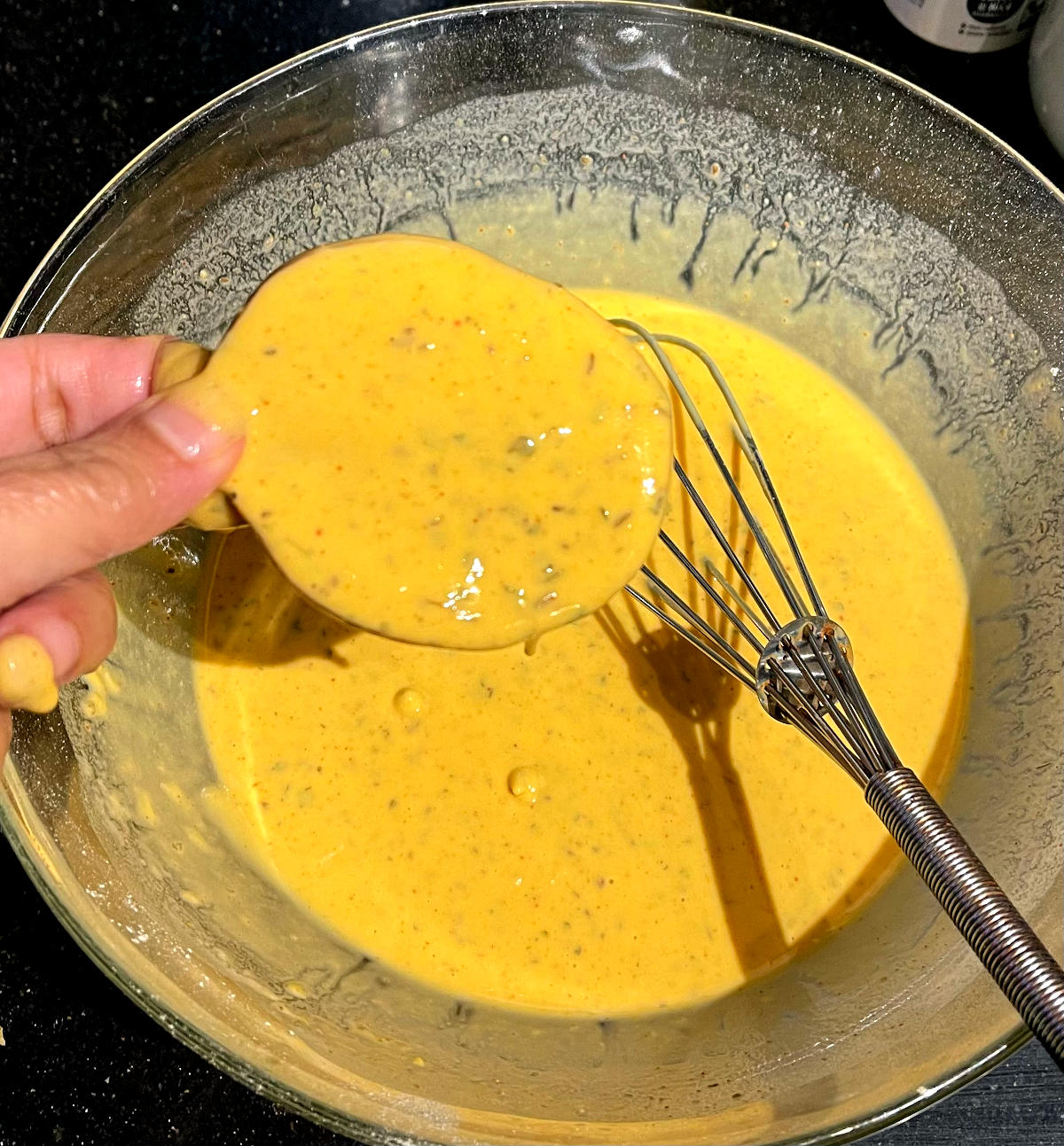
- Fry the pakoras. To fry the pakoras, dip the sliced potatoes and zucchini into the batter, one at a time, and carefully place in the hot oil in the wok. Fry until one side turns lightly golden, then flip over and cook the other side. Flip over once or twice more. You want a lovely, golden color on the pakora but you don't want them to brown. The pakoras will continue to take on a little more color after you've taken them out of the oil. To make cabbage or onion pakoras (I do this after I've finished making the potato and zucchini pakoras), place all of the chopped veggies into the remaining batter and mix. Scoop out chunks of the batter with the veggies and add them to the frying pan.
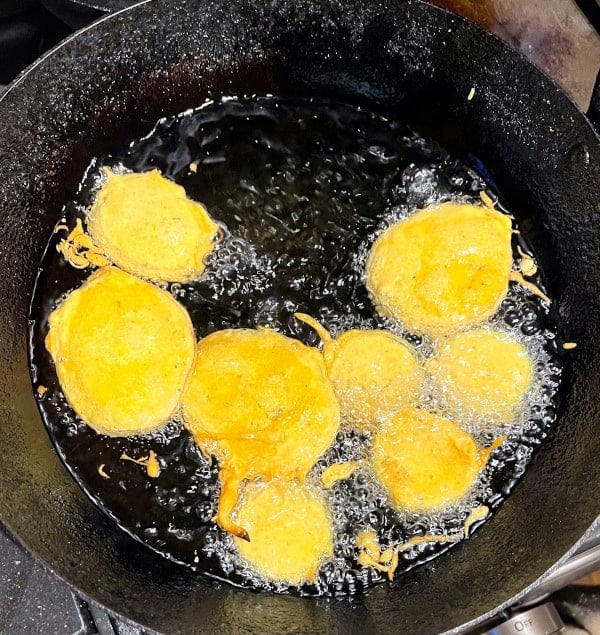
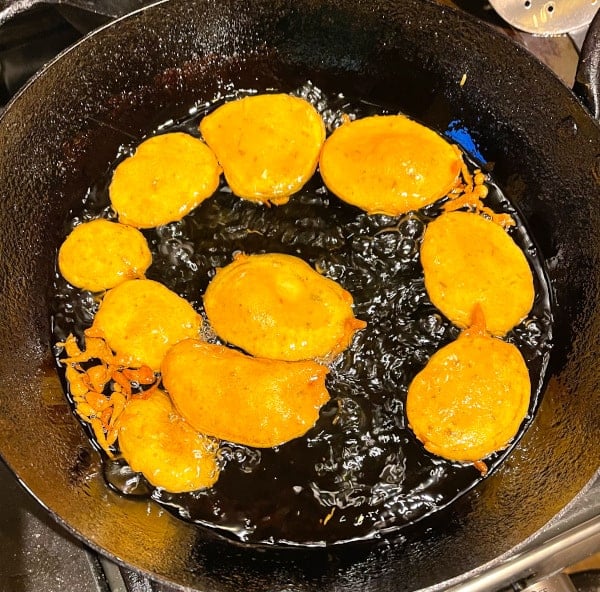
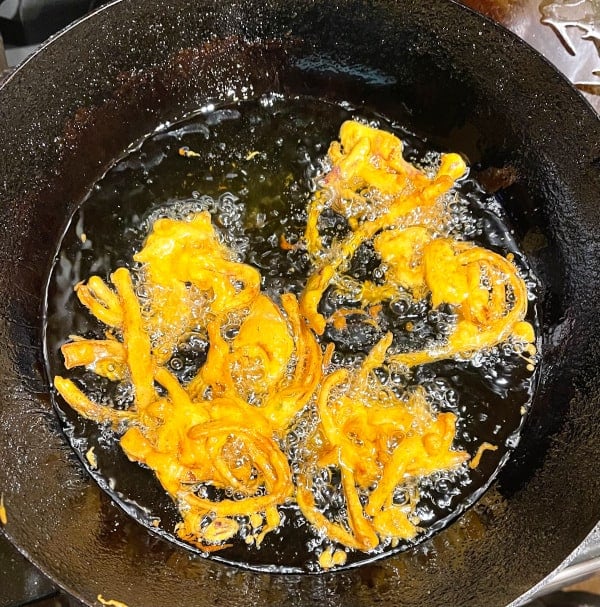
- Drain out any excess oil. When fried at the right temperature your pakoras will be perfectly crispy and not greasy, because they won't absorb much oil. Place the fried pakoras in a colander or plate lined with paper towels to absorb any excess fat clinging to them.
- Serve hot. Pakoras are best served hot, but wait about 5-10 minutes before serving as the juices from the veggies can be hot and might surprise the eater when they bite into the pakora. If you need to reheat them, do so in an oven preheated to 350 degrees Fahrenheit for five minutes. Don't let them brown. These pakoras remain crunchy hours after cooking, so you can just eat them at room temperature.
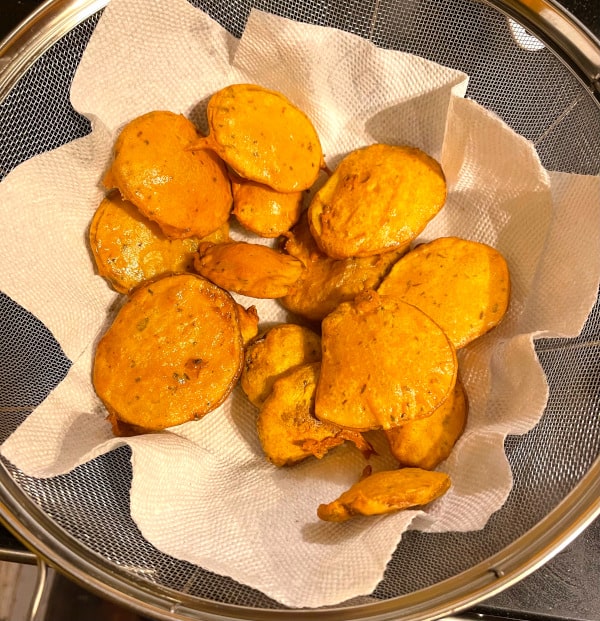
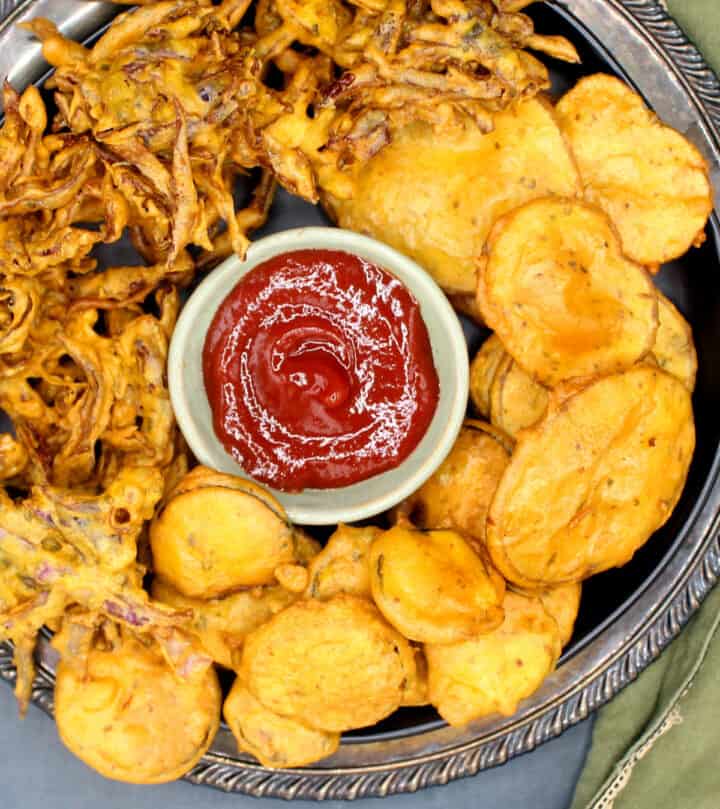
Top tips for the best pakora
- Slice the veggies or cut them into strips. Traditionally, vegetables like potatoes and eggplants are sliced, while onions are cut in thin strips, creating that classic "bird's nest" look when the strips, held together by the batter, are fried. If you use a leafy green like spinach or fresh methi (fenugreek), chop the leaves into small bits and then mix them into the batter. Grating the veggies is not preferred because the chickpea batter needs a little time to cook and by the time it has, the grated veggies will already have burned.
- Salt the batter adequately. Keep in mind that the fried pakoras will taste a little less salty than the batter. You can always taste the pakora after frying up the first batch and add more salt to the remaining batter, if needed.
- Don't brown the pakora. You might see photos of pakoras that look brown rather than golden, and that can only mean one thing: the pakoras are overcooked. By the time the pakora turns brown it has turned slightly bitter, so don't even go there! Take the pakoras out of the oil when they are a lovely, rich, golden color. They will continue to cook a bit more in the bit of oil surrounding them after coming off the heat.
- To keep the pakoras from absorbing too much oil use a thermometer. Maintaining the oil temperature between 350 degrees Fahrenheit/180 degrees Celsius and 375 degrees F/190 degrees C while frying will ensure that the veggies are cooked through and absorb very little oil, taking some of the guilt out of deep-frying!
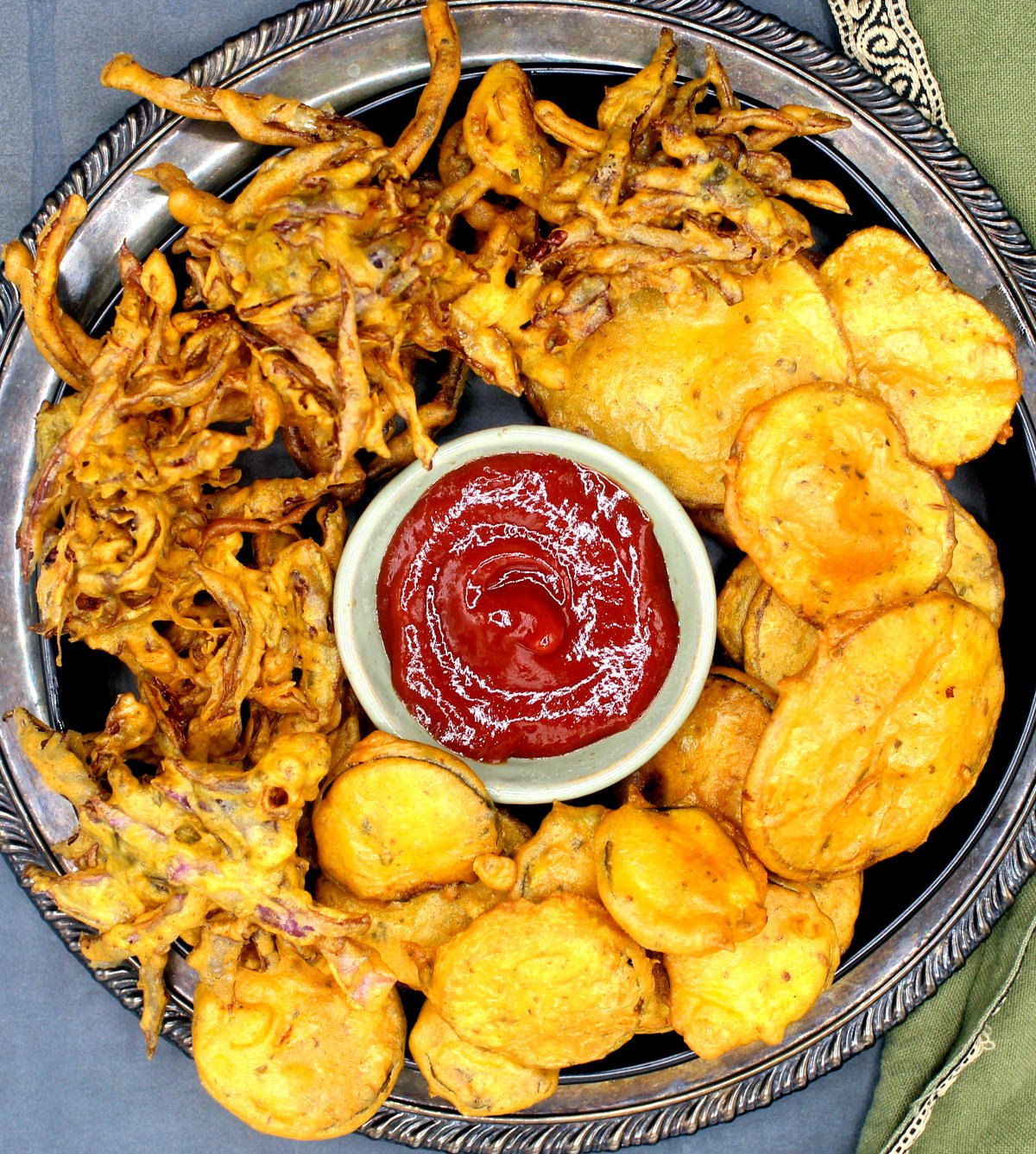
What to serve with pakora
- I love to bite into the crunchy pakora by itself or dunk it into mint chutney Spicy sauces sold at Indian stores, like Maggi masala chilli sauce, are also wonderful with pakoras. Kids love to dunk them in tomato ketchup.
- Serve a cup of masala chai or cutting chai with pakora. In summer, serve it with a glass of iced cardamom green tea.
Storage instructions
Store leftover pakoras in the refrigerator for up to three days. Place in an airtight box lined with a paper towel as soon as they cool down and refrigerate. Reheat for 5-7 minutes in a preheated oven before serving.
More tasty fritter recipes
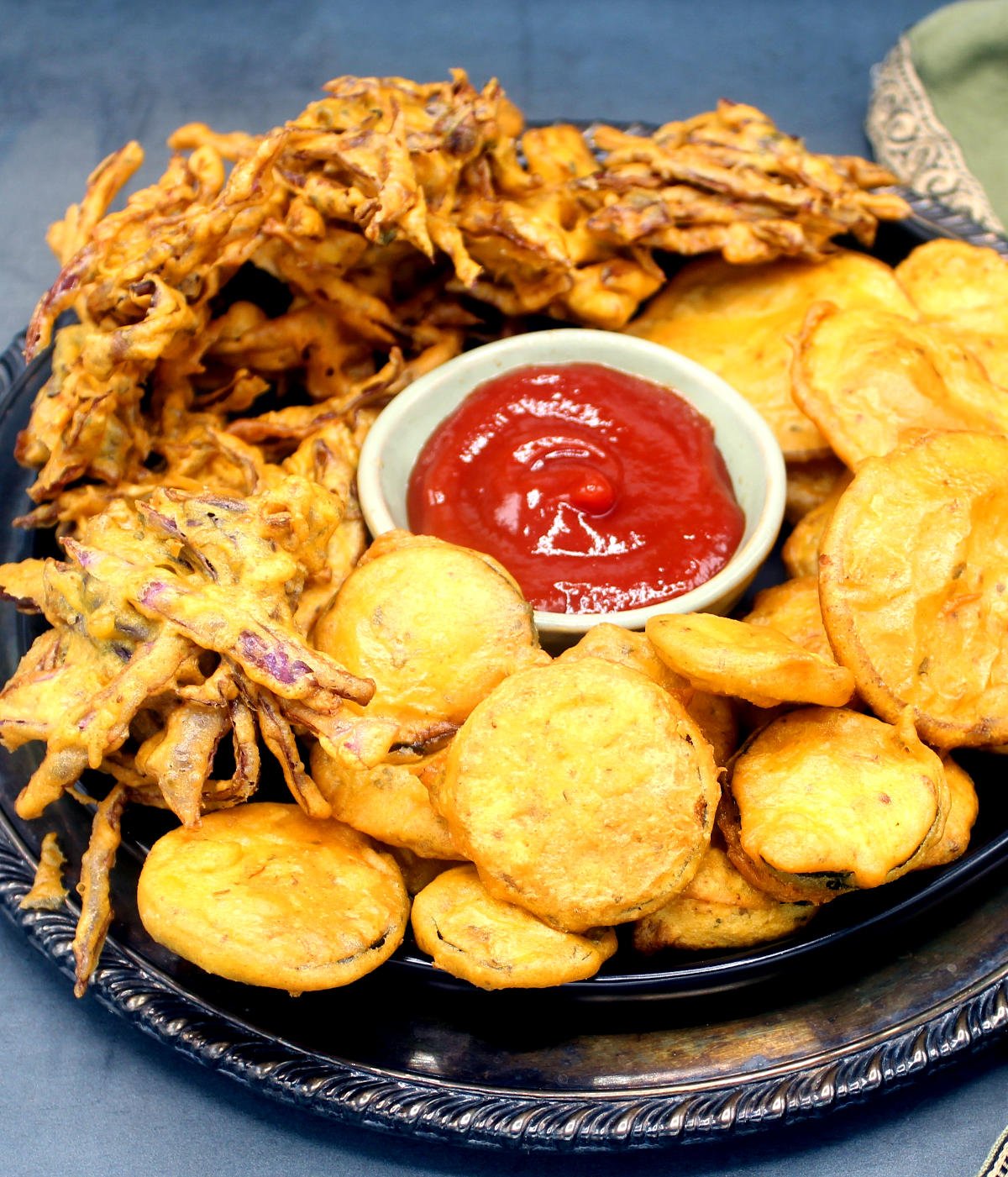
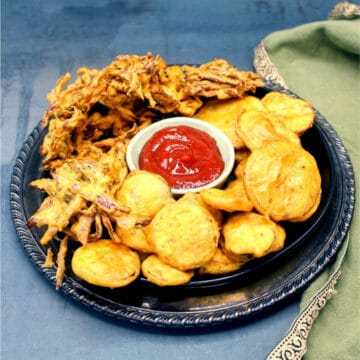
Vegetable Pakora
Equipment
- 1 Bowl
- Wok or frying pan (or deep fryer)
Ingredients
- 1 ½ cups besan (chickpea flour)
- 6 tablespoons rice flour
- 1 teaspoon cayenne (or any moderately spicy red chilli powder. Use less if you can't tolerate heat, more if you like your pakoda spicy.)
- ½ teaspoon turmeric
- 1 teaspoon ajwain (carom seeds. Grind coarsely by running a knife through the seeds or crush them slightly in a mortar and pestle. )
- 1 teaspoon cumin seeds (Grind coarsely by running a knife through the seeds or crush them slightly in a mortar and pestle.)
- 1 tablespoon kasoori methi (dry fenugreek leaves. Leave out if you don't have it, or add a teaspoon of dry mint leaves. You can also use two tablespoons of finely chopped fresh cilantro.)
- Salt to taste
- 1½ cups water
- 1 medium zucchini
- 1 medium red potato (or yellow potato)
- 1 medium onion (thinly sliced)
- 1 cup cabbage (thinly sliced)
- Avocado oil or any neutral oil (for frying. Add 2 inches of oil to the wok or frying pan. I use peanut oil. See ingredients notes above for which oils work best).
Instructions
- Heat oil. A wok is preferable, but if you don't have it a cast iron skillet or frying pan will work just as well. Or, if you have a deep fryer, use that. Use a thermometer, if you have one, to heat the oil to 350 degrees fahrenheit. Try and keep the temperature between 350 degrees and 375 degrees at all times so the veggies cook along with the chickpea coating and the pakoras don't change color too quickly.
- Chop the vegetables. Slice veggies like potatoes and zucchini thinly, using a knife or a mandolin. You want them to cook quickly in the oil. Chop the onions and cabbage into long, thin strands. You can make them as long or short as you like, I like mine gracefully long because I love how they look once they are fried.
- Whisk batter ingredients together: Place all the ingredients except the vegetables in a bowl. If the chickpea flour seems lumpy, sift it into the bowl. Whisk all the ingredients to mix.
- Add the water: Slowly begin to trickle in the water, a quarter cup at a time. Whisk, and then add more. Doing this will ensure you end up with a smooth, not lumpy, batter. It's very hard to get the lumps out of the batter once you've added all the water, so doing this slowly is really important.
- Check the consistency of the batter. Dip a veggie in the batter--I used a potato as you can see in the picture below. The excess batter should easily drip off while leaving a nice, even coating over the potato. You don't want a very thick batter because you should be able to taste the veggie and not just the coating, but you don't want a batter so thin that it just slides off the vegetable. To make pakoras with leafy veggies, or with veggies that have a slick surface like okra and asparagus, make the batter thicker.
- Fry the pakoras. To fry the pakoras, dip the sliced potatoes and zucchini into the batter, one at a time, and place in the wok. Fry until one side turns lightly golden, then flip over and cook the other side. Flip over once or twice more. You want a lovely, golden color on the pakora but you don't want them to brown. The pakoras will continue to take on a little more color after you've taken them out of the oil. To make cabbage or onion pakoras (I do this after I've finished making the potato and zucchini pakoras), place all of the chopped veggies into the remaining batter and mix. Scoop out chunks of the batter with the veggies and add them to the frying pan.
- Drain out any excess oil. When fried at the right temperature your pakoras will be perfectly crispy and not greasy, because they won't absorb much oil. Place the fried pakoras in a colander or plate lined with paper towels to absorb any excess fat clinging to them.
- Serve hot. Pakoras are best served hot, but wait about 5-10 minutes before serving as the juices from the veggies can be hot and might surprise the eater when they bite into the pakora. If you need to reheat them, do so in an oven preheated to 350 degrees Fahrenheit for five minutes. Don't let them brown. These pakoras remain crunchy hours after cooking, so you can just eat them at room temperature.
Notes
- Other veggies to use for pakoras: Cauliflower, broccoli, eggplant, bell peppers, okra, asparagus, corn, carrots or any leafy veggie, including spinach and kale.
- Make sure you check the salt in your batter. The fried pakora will taste a little less saltier, so make sure you adjust the salt accordingly in your batter as you can't salt the pakoras after they are cooked.
- Don't over-fry the pakoras. You want a lovely golden hue but don't let them start turning brown. The pakoras will darken a little more once you've taken them out of the oil.
- Maintain frying temps between 350 and 375 degrees Fahrenheit at all times. The pakoras will fry perfectly at this temperature and won't become greasy.
- Serve the pakoras with mint or tamarind chutney. You can also just serve them with a bottled masala sauce or ketchup.
- You can store leftover pakoras in the refrigerator for up to three days. Place in an airtight box lined with a paper towel as soon as they cool down and refrigerate. Reheat for 5-7 minutes in a preheated oven before serving. Don't let the pakoras brown.

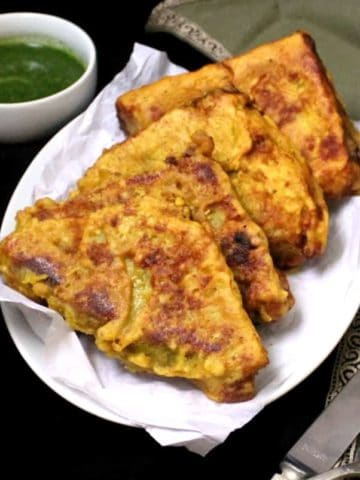
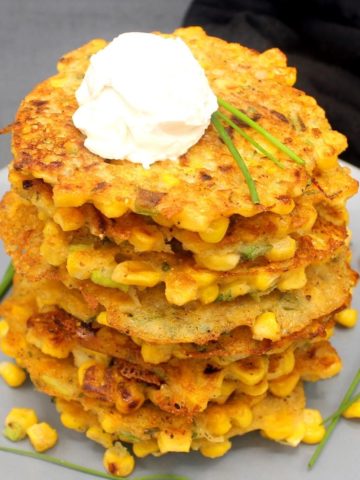
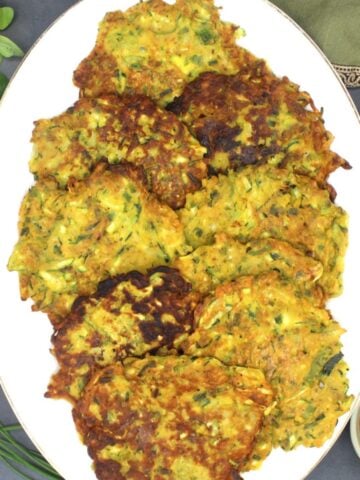
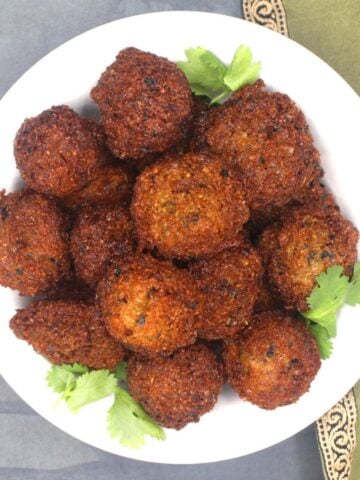
Rohini
These are simply divine. 😍
Marsha
Hi, I made these pakoras exactly per your instructions and they came out awesome. My family finished these in under 10 minutes, I barely got to taste one! 🙂
Vaishali
Yay, so happy you made them!!
Melissa K.
Hi, this is Melissa, I follow you regularly! Have you ever tried making pakoras (and/or samosas) in the air fryer? Or is the batter too thin?
Thank you!
Vaishali
Hi Melissa, you'd definitely need a thicker batter to air-fry. Add a cup of water instead of a cup and a half and give it a try!